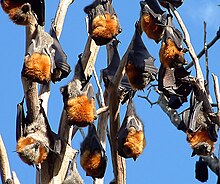Grey-headed Flying Fox
| Grey-headed flying fox | |
|---|---|
 |
|
| Scientific classification | |
| Kingdom: | Animalia |
| Phylum: | Chordata |
| Class: | Mammalia |
| Order: | Chiroptera |
| Family: | Pteropodidae |
| Genus: | Pteropus |
| Species: | P. poliocephalus |
| Binomial name | |
|
Pteropus poliocephalus (Temminck, 1825) |
|
 |
|
| Native distribution of P. poliocephalus | |
The grey-headed flying fox (Pteropus poliocephalus) is a megabat native to Australia. The species shares mainland Australia with three other members of the genus Pteropus: the little red flying fox (P. scapulatus), the spectacled flying fox (P. conspicillatus), and the black flying fox (P. alecto).
The grey-headed flying fox is endemic to the south-eastern forested areas of Australia, principally east of the Great Dividing Range. Its range extends approximately from Bundaberg in Queensland to Geelong in Victoria, with outlying colonies in Ingham and Finch Hatton in the north, and in Adelaide in the south. In the southern parts of its range it occupies more extreme latitudes than any other Pteropus species.
The grey-headed flying fox is the largest bat in Australia. This flying fox has a dark-grey body with a light-grey head and a reddish-brown neck collar of fur. It is unique among bats of the genus Pteropus in that fur on the legs extends all the way to the ankle. Adults have an average wingspan up to 1 m (3.3 ft) and can weigh up to 1 kg (2.2 lb). The head and body length is between 230 and 289 mm (9.1 and 11.4 in), with an average of 253 mm (10.0 in). The forearm length is between 138 and 180 mm (5.4 and 7.1 in), with an average of 161 mm. Weight generally varies between 600 and 1,000 g (1.3 and 2.2 lb), with an average of 677 g (1.493 lb). It is tailless, with claws on its first and second digits. Since it does not echolocate, it lacks tragus or leaf ornamentation found in most species of Microchiroptera. It relies on sight to locate its food (nectar, pollen and native fruits) and thus has relatively large eyes for a bat.
...
Wikipedia

